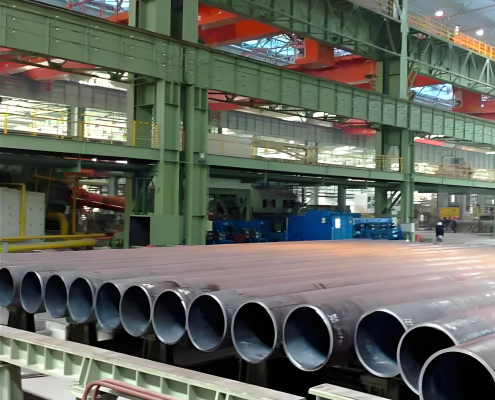Future Energy Steel provides high-quality seamless steel Gas Cylinder Tube that can withstand high pressure, adhering to JIS, GB, and EN standards. Common materials include 37Mn, 30CrMo, 35CrMo, and 34CrMo4. These tubes are essential for manufacturing gas storage tanks and accumulators and are known for their uniform wall thickness and high strength. Regular diameters range from 60mm, 70mm, 89mm, 108mm, 121mm, 127mm, 140mm, 159mm, 165mm, 180mm, 219mm, 229mm, 232mm, 267mm, 273mm, 279mm, 325mm, 356mm, 406mm, 559mm, 610mm, 660mm, 715mm, making them suitable for various industrial applications. With a strong market presence in South America and Europe, our gas cylinder tubes are among their most competitive products. Contact us at [email protected] for tailored solutions to meet your specific needs.
FAQs
What is Gas Cylinder Tube?
Gas cylinder tubes are specialized steel tubes used in the production of gas cylinders, which store and transport compressed gases such as oxygen, nitrogen, argon, and other industrial gases. These tubes are engineered to withstand high internal pressures and meet stringent safety standards to ensure the safe storage and handling of gases.
What are the Characteristics of Gas Cylinder Tubes?
Material Composition:
Typically made from high-strength carbon steel or alloy steel.
Steel grades like 34CrMo4 and 30CrMo are commonly used for their high tensile strength and toughness.
Manufacturing Process:
Seamless Tubing: Gas cylinder tubes are usually seamless to eliminate the risk of leaks or weaknesses at welded joints. The seamless process provides uniform strength and reliability.
Hot Rolling and Cold Drawing: The tubes are initially hot-rolled to form a rough shape, followed by cold drawing to achieve precise dimensions and improve mechanical properties.
Heat Treatment:
Heat treatment processes such as normalizing, quenching, and tempering are applied to enhance the material’s mechanical properties, such as strength, toughness, and ductility.
Dimensional Specifications:
Gas cylinder tubes are manufactured with precise dimensional tolerances for diameter, wall thickness, and length to ensure proper fit and function.
Common sizes range from small cylinders used in medical applications to large cylinders for industrial use.
Surface Finish:
Tubes may undergo surface treatments to enhance corrosion resistance and surface quality, such as shot blasting or polishing.
Safety Standards:
Manufactured according to international standards such as ISO 9809, EN 1442, and DOT (Department of Transportation) standards, which specify the requirements for material properties, design, and testing of gas cylinders.
What Are the Applications of Gas Cylinder Tubes?
Gas cylinder tubes are used in a wide range of applications across various industries:
Industrial Gases:
Welding and Cutting: Cylinders containing oxygen, acetylene, and other gases are used in welding and metal-cutting operations.
Chemical Processing: Used to store and transport gases required in chemical manufacturing processes.
Medical and Healthcare:
Medical Oxygen: Cylinders are used to supply oxygen to patients in hospitals, ambulances, and home healthcare settings.
Anesthetic Gases: Used in the storage and transport of anesthetic gases in medical facilities.
Automotive Industry:
Compressed Natural Gas (CNG): Used in vehicles powered by compressed natural gas as an alternative fuel source.
Hydrogen Fuel Cells: Cylinders are used in hydrogen-powered vehicles to store and transport hydrogen gas.
Firefighting and Safety:
Breathing Apparatus: Used in self-contained breathing apparatus (SCBA) for firefighters and rescue workers.
Fire Suppression Systems: Cylinders are used to store gases for fire suppression systems.
Food and Beverage Industry:
Carbonation: Used in the carbonation of beverages and for pressurizing beer kegs.
What Are the Advantages of Gas Cylinder Tubes?
High Strength: Engineered to withstand high internal pressures and mechanical stresses.
Safety: Designed and manufactured to meet stringent safety standards for reliable performance.
Versatility: Suitable for a wide range of gases and applications across various industries.
Durability: Provides long service life under demanding conditions.
What Are the Standards and Specifications for Gas Cylinder Tubes?
Several international standards specify the requirements for seamless steel tubes used in high-pressure gas cylinders. Here are some of the key standards:
ISO 9809-1/2/3:
ISO 9809-1: Seamless steel gas cylinders – Quenched and tempered steel cylinders with tensile strength less than 1,100 MPa.
ISO 9809-2: Seamless steel gas cylinders – Quenched and tempered steel cylinders with tensile strength greater than or equal to 1,100 MPa.
ISO 9809-3: Seamless steel gas cylinders – Normalized steel cylinders.
EN 1964-1: Seamless steel gas cylinders – Cylinders made of seamless steel tubes and intended for the transport of gases.
ASTM A519: Standard specification for seamless carbon and alloy steel mechanical tubing, commonly used in manufacturing gas cylinders.
JIS G3429: Japanese Industrial Standard for seamless steel tubes used in gas cylinders.
EN 10297-1: Standard specification for seamless carbon and alloy steel for mechanical and engineering purposes, commonly used in manufacturing gas cylinders.
GB 18248: China National Standard for seamless steel tubes for gas cylinders




